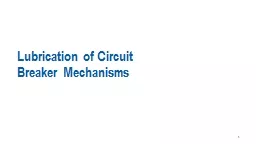

What is different about circuit breaker lubrication Many of the same components as other industries but they do not operate in the same way Long periods of inactivity Large temperature swings ID: 758179
Download Presentation The PPT/PDF document "1 Lubrication of Circuit Breaker Mechani..." is the property of its rightful owner. Permission is granted to download and print the materials on this web site for personal, non-commercial use only, and to display it on your personal computer provided you do not modify the materials and that you retain all copyright notices contained in the materials. By downloading content from our website, you accept the terms of this agreement.
Slide1
1
Lubrication of Circuit Breaker MechanismsSlide2
What is different about circuit breaker lubrication? Many of the same components as other industries,
but they do not operate in the same wayLong periods
of inactivity
Large temperature swings
Outdoor exposure
Much longer service intervals Wear is not usually an issue Slide3
Lubrication issues for MV circuit breakersGreases harden - do not have adequate life for typical CB maintenance intervals
No zerk fittings – lubrication is difficult
Oils deteriorate – chemical reaction with moisture, oxygen and heat
Labor
intensive
– requires major disassembly to maintainResult
– slow trips and no recloses; burned coils and motors
This oxidized and hardened grease no longer has lubricant in the thickenerSlide4
What is greaseGrease is a fluid lubricant (oil) mixed with a thickener. It often contains additives to give it special performance characteristicsSlide5
Types of oils and greasesPetroleum Oils (Mineral Oils)
Made from paraffinic or naphthenic oils Complex mixture of different crude oils
Little control over molecular structure means variation of lubricating properties
Synthetic Oils
– many unique
namesManufactured from few raw material components
Desired lubricant properties can be controlled
PAO
is acronym for polyalphaolifin: very good lubricating properties; suitable for many bearing, bushing and moving contact applications
Ester
oils have polarity that attracts them to steel bearing surfaces: very good lubricating properties; moisture can be absorbed over time, which degrades themSlide6
Types of oils and greasesSilicone
oils Usually have very good oxidation and evaporation properties: good choice for low temperature, moderate load, long life applications
Applications include moving switch contacts
Compatible with many plastic materials.
.
Fluorosilicone
oils
Excellent resistance to oxidation, evaporation and wash-out from water or chemicals such as degreasers and
penetrantsSlide7
The components of greaseGrease Thickeners
Thickeners are classified as soap or non-soap Soap thickeners include aluminum, calcium, sodium and lithium
Non-soap thickeners include silica gel, clay, urea and PTFE
Soap thickener can be combined with other materials to raise the temperature at which the grease liquefies. The greases made with these enhanced thickeners are called complex greases. Thickeners are used to make the lubricating fluid semi-solid so it does not flow out of tight spaces.
Additives
Mostly used to enhance properties of the base oils
Antioxidants
Corrosion inhibitors
Anti-wear
Viscosity stabilizersSlide8
Selection of grease
Remove old
grease or be
aware of
thickener compatibility
Consider
low temperature
performance and other environmental factors
Choose
a
synthetic
grease. There is no advantage of petroleum base grease for circuit breaker applications. What
life
do you want?
Select a grease with base oil that resists
oxidation
. This is key to long, satisfactory performance.
Synthetic oils
have much better oxidation characteristics than petroleum oils because of the control of properties during manufacturing. PAO and ester oils, except for the low molecular weight oils, have both good oxidation and good evaporation characteristics.
Silicone and
fluorosilicone
oils used in greases have even better oxidation and evaporation properties, resulting in longer life
.Slide9
New methods: MaterialsFluorosilicone
oil. It is thin enough to penetrate tight clearances, evaporates very slowly and does not oxidize. It is a good lubricant and has long life.Fluorosilicone grease (
eg. Dow 3451 grease) is used where parts can be reached.Slide10
Basics
Yearly Exercise During preventative maintenance Rejuvenate grease with a compatible oil.
Lubricate all pivot points with oil , in various positions during maintenance charged / discharged / open / closed.
Clean old grease off and apply new grease lightly.
Never use aerosol penetrating solvents they are temporary and dry out any remaining oil in the grease.
Upgrade to longer lasting grease during overhaul activities.